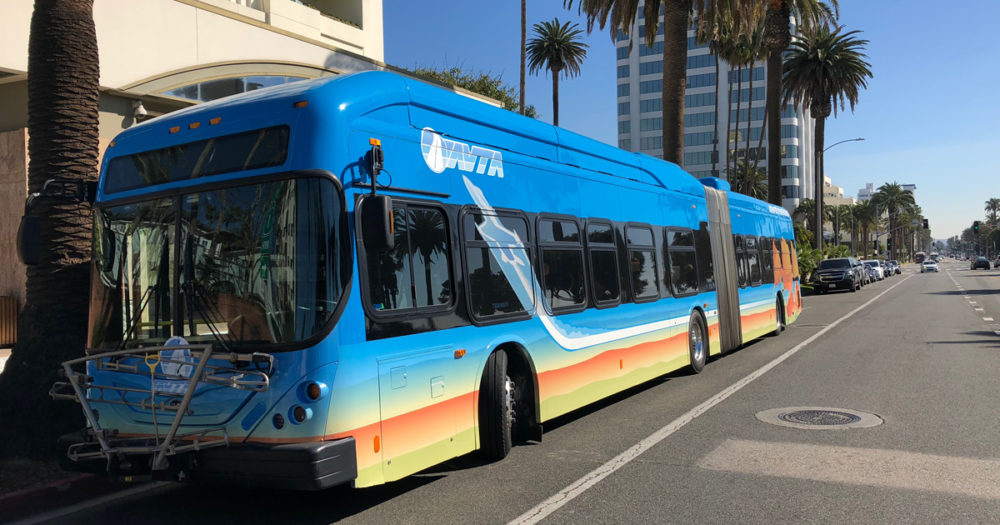The California Air Resources Board (CARB) recently released a draft standard for transitioning the state’s transit buses to zero-emission battery or fuel cell technologies by 2040. This is great news for bus riders, bus drivers, local air quality, and tackling global warming emissions from the transportation sector.
The proposal is the result of more than three years of stakeholder engagement and public comment. In the process, CARB has generated a wealth of knowledge, including a sophisticated total cost of ownership analysis, a charging cost calculator, and a thorough understanding of the on-the-ground challenges to deploying a new technology on a large scale.
As a key step in the official regulatory process, the standard will be discussed and public comment heard at the September 27-28 CARB Board Meeting. A final vote will occur at a subsequent Board Meeting (date to be determined).
What’s being proposed?

For large transit agencies (100 or more buses), 25 percent of bus purchases must be battery or fuel cell electric vehicles beginning in 2023. This increases to 50 percent in 2026 and 100 percent in 2029.
For small agencies, the proposed purchase standard doesn’t begin until 2026 (at 25 percent) and increases to 100 percent in 2029. Thirty of the state’s 214 transit agencies fall into the definition of a “large” agency and represent 75 percent of buses in the state.
When CARB began hosting workshops in 2015, the purchase standard was scheduled to take effect in 2018. So, the current proposal represents a five-year delay from CARB’s original plan.
To encourage early adoption, the 2023 purchase standard will be waived if 1,000 zero-emission buses have been purchased across the state by the end of 2020. If an additional 150 zero-emission buses are purchased by the end of 2021, the purchase standard will remain waived until 2025.*
With more than 130 zero-emission transit buses already operating in California, several hundred more on order, and significant amounts of incentive funding allocated for buses, transit agencies are already on track to exceed the early-adoption thresholds.
Finally, the standard also requires agencies to develop and submit plans to CARB for how they will reach a 100 percent zero-emission fleet by 2040. These plans will be critical to transit agencies’ successful incorporation of zero-emission vehicles in their fleets.
Which buses are included in the standard?
“Buses” in the context of this proposal include standard 30 to 40-foot buses, shuttle buses (cutaway buses), articulated buses, coach buses, and double-decker buses operated by transit agencies. There are 14,600 transit buses falling under this definition in California. For reference, the city of Shenzhen in China (population of 12 million people compared to California’s 40 million people) already has 16,000 electric buses on the road.
The chart below shows a breakdown of California’s transit bus population by type (not shown are double-decker buses, of which there were only six in the most recent survey).

The standard’s percentages apply to purchases, not the total makeup of a fleet
Given transit buses are typically on the road for 14 years, this corresponds to a fleet turnover rate of roughly 7 percent each year. So, a 25 percent purchase standard in 2023 works out to roughly 2 percent of total buses on the road across all agencies.

Looking at bus purchases statewide over the last five years, the 25 percent purchase standard in 2023 corresponds to about 150 zero-emission buses. The 50 percent purchase standard in 2026 corresponds to about 550 zero-emission buses.**
Individual transit agencies don’t necessarily turnover 7 percent of their fleet every year; instead making larger purchases every few years as shown in these two charts. Transit agencies’ different purchasing schedules points to the need for individual rollout plans in addition to purchase standards.
For a large agency like San Diego MTS, the 25 percent purchase standard corresponds to about 12 buses based on MTS’ purchase history. For a small agency like Sonoma County Transit, a 25 percent purchase standard corresponds to about 2 buses.
The chart above shows bus population by age in California (zero years old corresponds to 2016). More than half the buses on the road are from 2009 or earlier, which has significant implications for air quality as these vehicles were not subject to the latest engine standards. A combustion bus from before 2010 can have up to 30 times higher NOx tailpipe emissions compared to its newer combustion counterpart.
Three ways CARB can improve the proposed standard
1. The standard should clearly state that all buses must be zero-emission by 2040. Since CARB began workshops in May 2015, the goal of this standard has been achieving a full transition to zero-emission buses by 2040, yet the actual language of the standard doesn’t explicitly say this. In fact, it could be several years past 2040 when the full transition is achieved based on how the standard is currently written.
The rule’s proposed standard of 100 percent zero-emission buses purchases beginning in 2029 would guarantee a transition by the end of 2040 only for buses on the road for 12 years. But many buses in California are on the road for 14 years or longer and there is up to a two-year lag between when a bus is purchased and when it hits the road, so a 2029 purchase standard would likely not achieve the goal of all zero-emission buses by 2040. Anything past 2040 ignores the state of technology and how quickly other jurisdictions are making this transition, namely in China.
2. The standard should apply to shuttle, articulated, coach, and double-decker buses sooner. Under the proposed rule, these buses are not subject to the purchase standard for eight years despite comprising one-third of transit buses.
Waiting until 2026 would miss an opportunity to reduce emissions from these buses. Several models of these buses are on the road today and becoming increasingly available across manufacturers. We recommend these buses fall under the purchase standard two years after at least two models of a given type of bus have completed testing by the Federal Transit Administration.
If you haven’t been following the electric bus industry, there are currently 14 companies that make over 30 different models of buses ranging from standard transit buses to shuttle buses, coach buses, double-decker buses, and long, articulated buses.***

3. Small transit agencies should submit transition plans by 2021 to take advantage of current incentive funding. Under the draft plan, transit agencies with less than 100 buses have until 2023 to submit plans for transitioning their fleets to zero-emission buses by 2040. If these transit agencies wait five years to come up with a plan, they could miss taking advantage of the significant amount of incentive funding currently available across the state for the bus itself as well as electric vehicle charging infrastructure. And due to the gaps between agencies’ purchases, a delay in planning could result in a several year delay in deploying zero-emission buses.
Why a standard is needed
In the three years CARB’s standard has been under development, there has been a significant increase in the number of transit agencies deploying zero-emission buses. Twelve agencies (see below) have made voluntarily commitments to 100 percent zero-emission fleets. These agencies represent both small and large fleets and operate 37 percent of the state’s total buses.
Antelope Valley Transportation Agency is working to transition its 85 bus fleet by the end of this year. LA Metro, the second largest bus fleet in the country, has committed to transitioning its fleet by 2030, a full 10 years ahead of what the state standard will achieve.

With leadership shown by these agencies, it’s important to acknowledge that a state-wide standard is critical to realizing the benefits of zero-emission buses across the state. AC Transit, in its plan to rollout 144 electric buses by 2032, directly references CARB’s proposed standard as a motivating factor in creating the agency’s plan.
If you look at the actual language of the proposed standard, you’ll notice it is a revision to an existing standard, first adopted 18 years ago. California’s early demonstration of zero-emission bus technology, such as fuel cell buses operated at Sunline Transit and AC Transit, can be traced to the original standard.
The proposed standard is a reasonable next step. The standard is achievable and without it, zero-emission buses would see a slow deployment. The technology is here, the public health and climate benefits are significant. The thoughtful conversations and detailed analyses have been had. The standard should be approved and California should continue to show we are a state that embraces solutions to air pollution and global warming.
* CARB’s draft standard also awards credits to agencies with zero-emission buses already on the road that can be used to offset future purchase requirements. Current credits correspond to roughly 150 buses.
** The purchase estimate in 2023 is based only on standard bus purchases made by large transit agencies. The purchase estimate in 2026 includes purchases made by small agencies and accounts for shuttle, articulated, coach, and double-decker buses.
*** The list of bus manufacturers and models includes those available for purchase if not already on the road.
Check out our Got Science? podcast for more on transit buses, the people’s electric vehicle:

